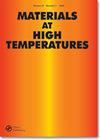求助PDF
{"title":"ATI 718Plus的蠕变断裂性能——一种稀疏数据评估方法","authors":"C. Bullough, E. Debruycker, E. Poggio, M. Schwienheer, M. Spindler","doi":"10.1080/09603409.2022.2135721","DOIUrl":null,"url":null,"abstract":"ABSTRACT The nickel-base alloy ATI 718Plus © (UNS N07818) was introduced in 2003 with the intention of providing similar properties to Waspaloy but having the fabricability of Alloy 718. Such characteristics make it of strong interest for use in aeroengines for disk forgings, blades and bolting bar. Within power generation, the advent of higher temperatures in industrial gas turbines, and advanced supercritical steam turbines, the combination of properties and processability make it an increasingly attractive proposition for a range of applications. This paper reports an exploratory creep test programme of beyond 30 kh duration leading to an Interim ECCC Datasheet on ATI 718Plus. It demonstrates how even small volumes of test data can be assessed to produce a datasheet that can be used for preliminary design. In particular, it considers how best to determine the rupture behaviour, by including the data from unfailed tests, using both polynomial and Wilshire Equation models, with coefficients estimated by conventional regression estimation, and also with maximum likelihood methods. Additionally, creep-strain time data are modelled and extrapolated, using simplified equations developed and/or applied within the ECCC in recent work. The results confirm the temperature advantage in creep of 718Plus over Alloy 718. Recommendations of how to assess sparse datasets have also resulted from this work, leading to an expectation that new materials can be developed more quickly and with higher reliability. Nevertheless, there is no substitute for long-term multi-heat testing to prove the predicted behaviour and to examine the stability of materials in the long term.","PeriodicalId":49877,"journal":{"name":"Materials at High Temperatures","volume":"1 1","pages":"655 - 667"},"PeriodicalIF":1.0000,"publicationDate":"2022-10-31","publicationTypes":"Journal Article","fieldsOfStudy":null,"isOpenAccess":false,"openAccessPdf":"","citationCount":"1","resultStr":"{\"title\":\"Creep rupture properties of ATI 718Plus – an approach to assessing sparse data\",\"authors\":\"C. Bullough, E. Debruycker, E. Poggio, M. Schwienheer, M. Spindler\",\"doi\":\"10.1080/09603409.2022.2135721\",\"DOIUrl\":null,\"url\":null,\"abstract\":\"ABSTRACT The nickel-base alloy ATI 718Plus © (UNS N07818) was introduced in 2003 with the intention of providing similar properties to Waspaloy but having the fabricability of Alloy 718. Such characteristics make it of strong interest for use in aeroengines for disk forgings, blades and bolting bar. Within power generation, the advent of higher temperatures in industrial gas turbines, and advanced supercritical steam turbines, the combination of properties and processability make it an increasingly attractive proposition for a range of applications. This paper reports an exploratory creep test programme of beyond 30 kh duration leading to an Interim ECCC Datasheet on ATI 718Plus. It demonstrates how even small volumes of test data can be assessed to produce a datasheet that can be used for preliminary design. In particular, it considers how best to determine the rupture behaviour, by including the data from unfailed tests, using both polynomial and Wilshire Equation models, with coefficients estimated by conventional regression estimation, and also with maximum likelihood methods. Additionally, creep-strain time data are modelled and extrapolated, using simplified equations developed and/or applied within the ECCC in recent work. The results confirm the temperature advantage in creep of 718Plus over Alloy 718. Recommendations of how to assess sparse datasets have also resulted from this work, leading to an expectation that new materials can be developed more quickly and with higher reliability. Nevertheless, there is no substitute for long-term multi-heat testing to prove the predicted behaviour and to examine the stability of materials in the long term.\",\"PeriodicalId\":49877,\"journal\":{\"name\":\"Materials at High Temperatures\",\"volume\":\"1 1\",\"pages\":\"655 - 667\"},\"PeriodicalIF\":1.0000,\"publicationDate\":\"2022-10-31\",\"publicationTypes\":\"Journal Article\",\"fieldsOfStudy\":null,\"isOpenAccess\":false,\"openAccessPdf\":\"\",\"citationCount\":\"1\",\"resultStr\":null,\"platform\":\"Semanticscholar\",\"paperid\":null,\"PeriodicalName\":\"Materials at High Temperatures\",\"FirstCategoryId\":\"88\",\"ListUrlMain\":\"https://doi.org/10.1080/09603409.2022.2135721\",\"RegionNum\":4,\"RegionCategory\":\"材料科学\",\"ArticlePicture\":[],\"TitleCN\":null,\"AbstractTextCN\":null,\"PMCID\":null,\"EPubDate\":\"\",\"PubModel\":\"\",\"JCR\":\"Q4\",\"JCRName\":\"MATERIALS SCIENCE, MULTIDISCIPLINARY\",\"Score\":null,\"Total\":0}","platform":"Semanticscholar","paperid":null,"PeriodicalName":"Materials at High Temperatures","FirstCategoryId":"88","ListUrlMain":"https://doi.org/10.1080/09603409.2022.2135721","RegionNum":4,"RegionCategory":"材料科学","ArticlePicture":[],"TitleCN":null,"AbstractTextCN":null,"PMCID":null,"EPubDate":"","PubModel":"","JCR":"Q4","JCRName":"MATERIALS SCIENCE, MULTIDISCIPLINARY","Score":null,"Total":0}
引用次数: 1
引用
批量引用
Creep rupture properties of ATI 718Plus – an approach to assessing sparse data
ABSTRACT The nickel-base alloy ATI 718Plus © (UNS N07818) was introduced in 2003 with the intention of providing similar properties to Waspaloy but having the fabricability of Alloy 718. Such characteristics make it of strong interest for use in aeroengines for disk forgings, blades and bolting bar. Within power generation, the advent of higher temperatures in industrial gas turbines, and advanced supercritical steam turbines, the combination of properties and processability make it an increasingly attractive proposition for a range of applications. This paper reports an exploratory creep test programme of beyond 30 kh duration leading to an Interim ECCC Datasheet on ATI 718Plus. It demonstrates how even small volumes of test data can be assessed to produce a datasheet that can be used for preliminary design. In particular, it considers how best to determine the rupture behaviour, by including the data from unfailed tests, using both polynomial and Wilshire Equation models, with coefficients estimated by conventional regression estimation, and also with maximum likelihood methods. Additionally, creep-strain time data are modelled and extrapolated, using simplified equations developed and/or applied within the ECCC in recent work. The results confirm the temperature advantage in creep of 718Plus over Alloy 718. Recommendations of how to assess sparse datasets have also resulted from this work, leading to an expectation that new materials can be developed more quickly and with higher reliability. Nevertheless, there is no substitute for long-term multi-heat testing to prove the predicted behaviour and to examine the stability of materials in the long term.


